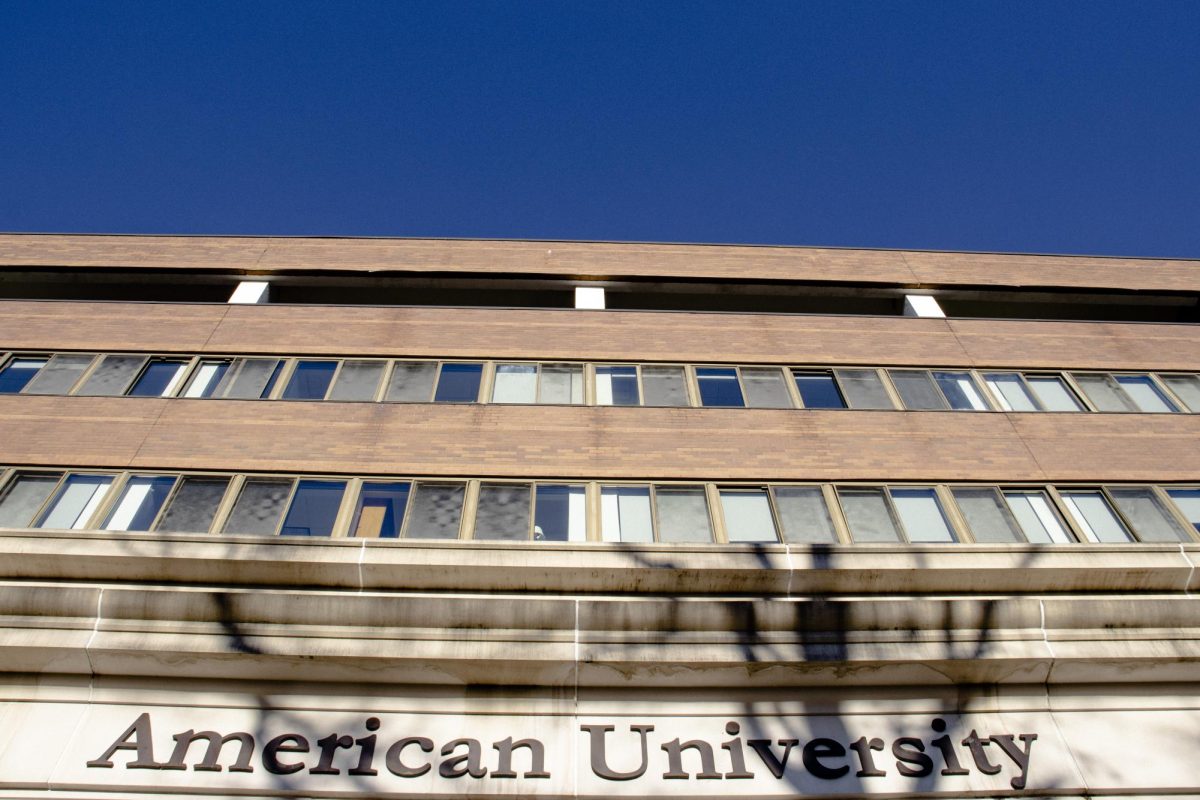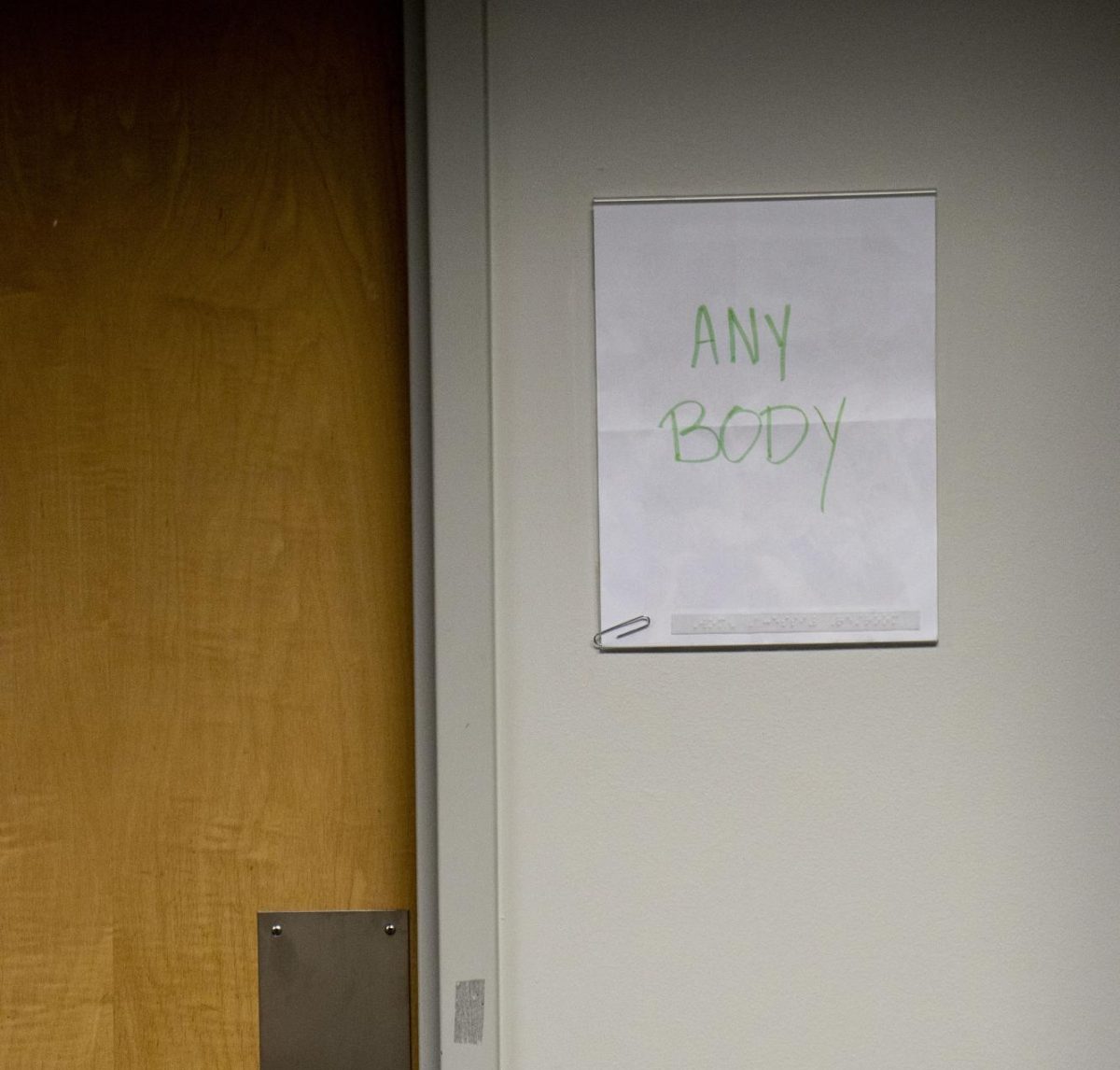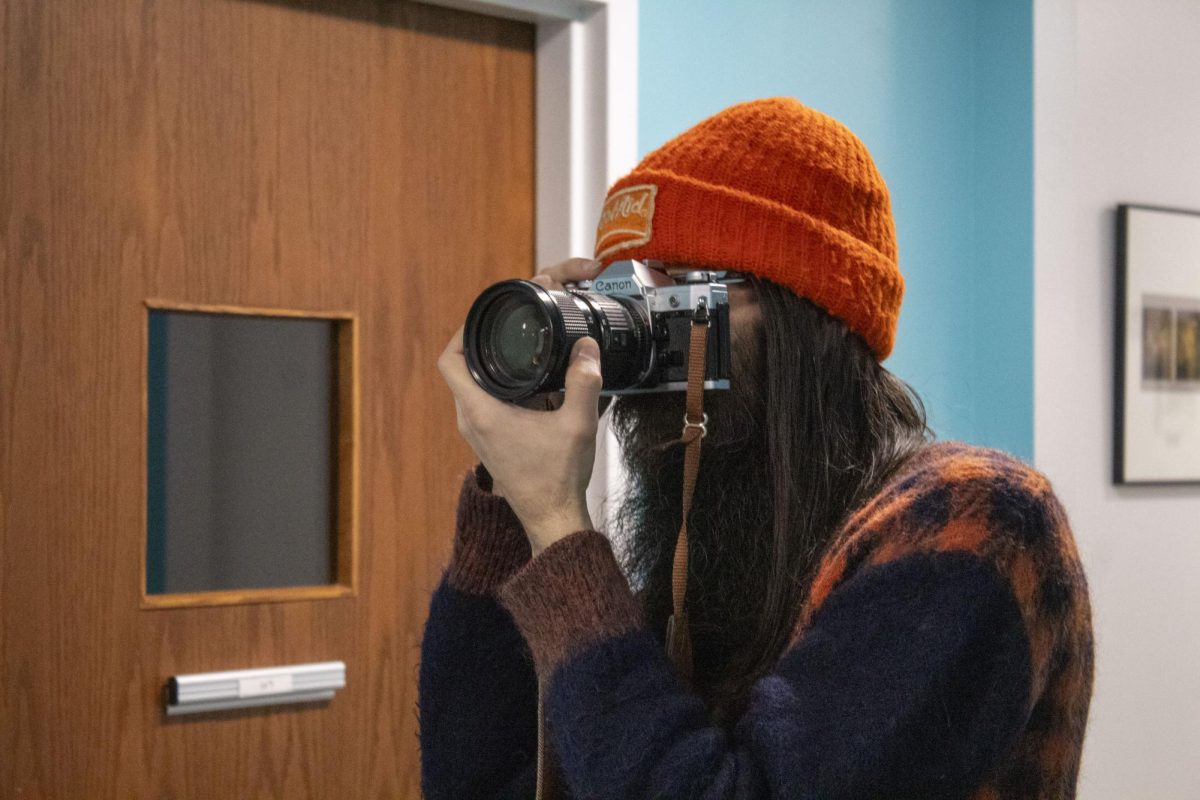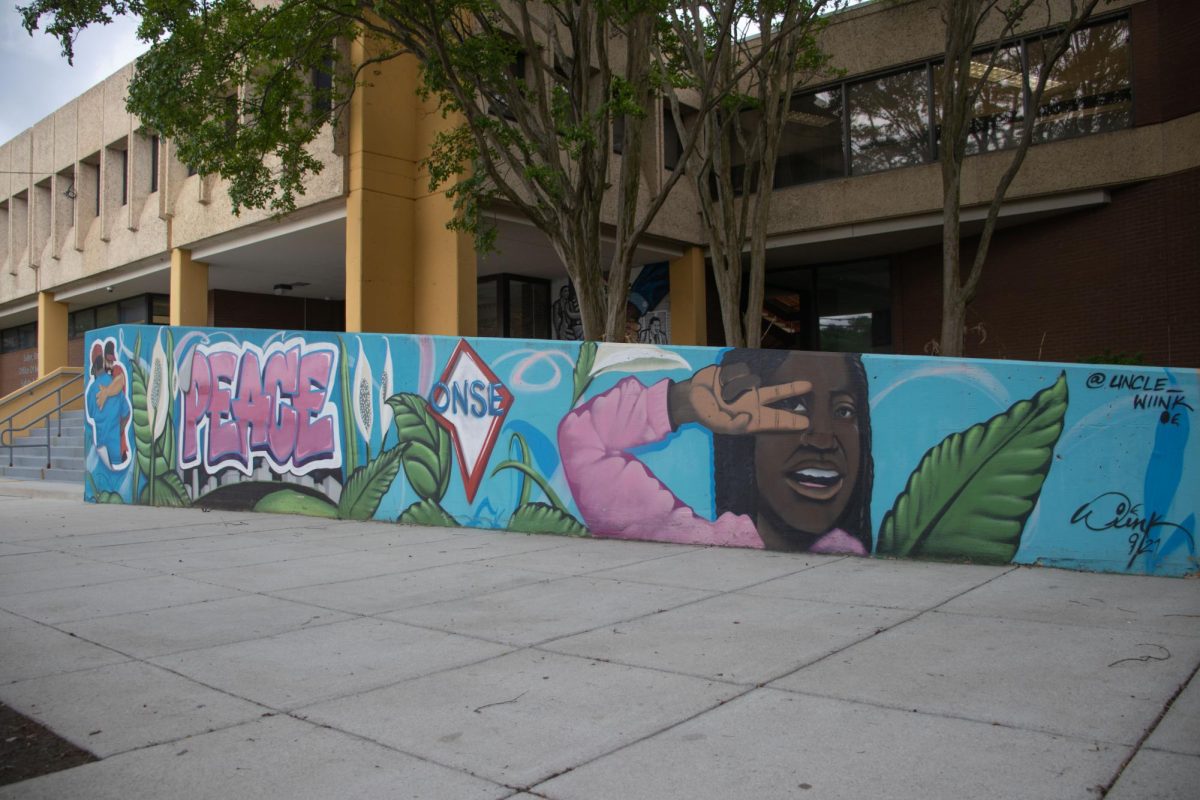Editor’s Note: This article includes mentions of police brutality, particularly against BIPOC and disabled people. It also includes mentions of gun violence.
Ben Austin contributed reporting to this article.
In the early afternoon on Oct. 17, 15 students picked up cardboard etched with “Is safety a priority? No more guns,” “Schools not war zones” and “Keep guns off our campus” and called for American University to not arm campus police.
Organized by AU’s March for Our Lives chapter, they donned sweatshirts, caps and jackets and shouted into the autumn wind. Five spoke to the possibility of arming AU police officers leading to police brutality, an undue budgetary burden and fear among students.
The university first notified students that it would consider arming the AU Police Department on Oct. 4, 2023. This year, the university held two education sessions in September and nine community forums in October to educate community members and receive input on its options.
Those options include AU police officers maintaining their current arsenal of pepper spray and batons, expanding the types of less-than-lethal weapons they carry, arming only police vehicles with firearms and arming all officers, according to AU’s security review website. Community members have vocalized concerns about spending resources to arm AUPD, fearing the possibility of police bias and brutality, while others have shown support for firearms in light of recent campus lockdowns.
At multiple education sessions in September, Chief Financial Officer Bronté Burleigh-Jones said a member of AU’s Board of Trustees, whom she did not name, first raised the question of arming AUPD last fall.
President Jonathan Alger will make the final decision, which will be announced in February 2025 after AU leaders review a draft report, according to the security review website and Burleigh-Jones. Members of AU’s administration have repeatedly said at forums that no decision has yet been made.
“When are they going to pull their gun out?”
Nine students at an Oct. 9 community forum said they’d feel less safe near AUPD officers if they were armed. The change would potentially increase fear on campus and harm disabled students, students of color and student protestors, they said. One student said they would be less likely to call AUPD in an emergency.
In forums and on ballots, the majority of students have objected to arming AUPD.
Between Oct. 8-11, 2,093 students voted in the American University Student Government election, which included multiple referenda about arming AUPD.
Of the students who voted, 80.17% were against arming AUPD officers and supervisors with sidearms during their regular patrol duty on campus, according to the AUSG’s election results spreadsheet. Slightly fewer voters, 70.56%, were against stationing firearms in AUPD cars. 58.67 percent voted against arming AUPD officers and supervisors with “less-than-lethal” weapons such as tasers or rubber bullets while on normal patrol duty on campus. 43.96 percent of voters said they trusted AUPD to protect their safety as well as the safety of faculty, staff and other students in the campus community. In contrast, 37.94% said they did not trust AUPD to do so.
Student efforts against arming officers began outside of AUSG. University alumna Reilly Phelan and junior Joey Katzenell, who uses they/she pronouns, created a petition in January citing potential for gun violence and pre-existing campus safety measures as reasons to not arm police. As of Nov. 21, the petition has received 559 signatures.
“We should be doing something for this as a gun violence prevention group,” they said.
Katherine Greenstein, a graduate student and co-founder of the Disabled Student Union, said arming AUPD is an immediate threat to disabled students on campus. Nationwide, half of people killed by police are disabled, according to the Center for American Progress, a public policy research and advocacy institute.
Greenstein said they’re worried about armed officers using disproportional force in a medical emergency or crisis. Students at the Oct. 9 forum also raised this concern. AUPD officers respond to medical emergencies and mental health crises, according to AU’s emergency procedures and the AUPD website.
“When are they going to pull their gun out? That’s the question that I’m concerned about,” Greenstein said. “And how much training are we able to do that’s going to prevent them from that? And the answer is there is no amount of training that will stop a police officer from grabbing their gun in that moment, because it happens all the time.”
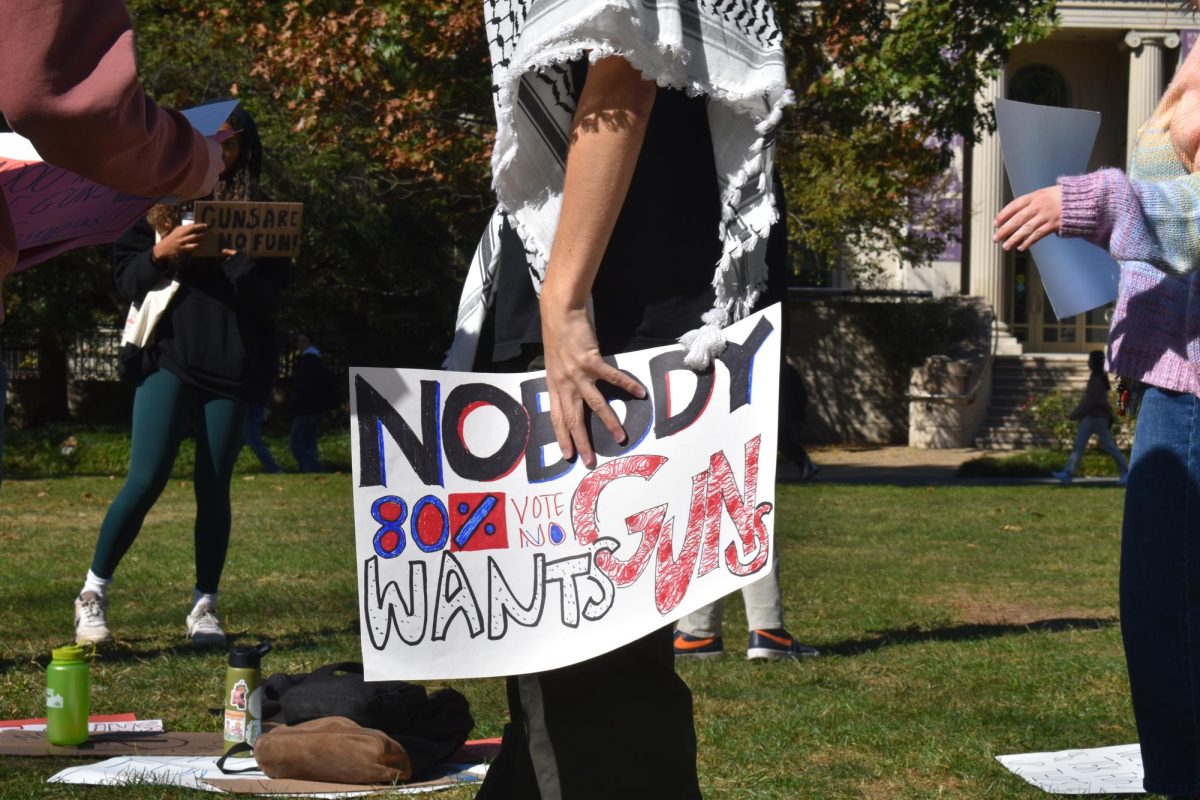
After AUPD received a report of a gun on campus on Oct. 14, some students have reconsidered arming campus police. Campus was put on lockdown before the gun was found to be a toy, according to an email from Burleigh-Jones and Phil Morse, assistant vice president for university police services and emergency management.
Joycelyn Hutchinson, a sophomore and the political action chair of the AU NAACP chapter, said some chapter members began to consider firearms as potentially necessary to stop threats. The thought that another student could be a threat made them especially fearful, she said.
“I think that it opened students up to the possibility of recognizing that a student could have a firearm on campus and nobody would know,” Hutchinson said. “And I think that makes some students feel unsettled.”
But from Katzenell’s perspective, arming police won’t address the threat of shootings, which they said they’re anxious about. Responses may be targeted toward marginalized communities, fostering fear and distrust among community members, Katzenell said.
“The trust we have — the little bit of trust that we have — with our security would just be broken,” they said. “And if we can’t trust the people keeping us secure, who are we supposed to trust other than each other?”
“Police are called by and used against people.”
Justin Morgan was a sophomore in 2013 when AUPD knocked on the door of his Hughes Hall dorm.
Morgan, a Black man who is now an adjunct professor in AU’s department of health studies, said he and a group of friends entered the building behind a group of white students. The desk assistant asked him to show his ID. Morgan said his ID was in the bottom of his bag, so he walked past the desk.
“I especially didn’t feel like doing it because, at the time, it felt like I was the only person getting asked to do it,” Morgan said. “Like a lot of people walk by.”
The desk assistant called AUPD. Though Morgan said the officers were reasonable, he said his experience shows the risk of arming police. He said groups use police against others, and if the police were armed, they’d be pointing guns at specific members of the community. Morgan’s concern isn’t just with police officers, he said, but with the students who call them: he does not trust AU students to de-escalate before calling AUPD.
“Ultimately, police are called by and used against people,” Morgan said. “And so putting the power of an armed police in the hands of other AU students is not particularly appealing to me, because AU students aren’t perfect.”
Police brutality and bias were at the center of most October discussions. At an Oct. 9 community forum for students who are against arming officers, four students said giving police officers weapons would increase the chance of violence and fatal shootings against people of color.
Racial bias in policing is a reality in Washington. In 2022, Metropolitan Police Department officers used force 2,363 times, almost 86.8% of which were against a Black person, according to the MPD’s 2022 use of force dataset. By comparison, Black adults made up 41% of the district’s adult population that year, according to data published to EdScape, a D.C. government datasets website.
Delores Jones-Brown, professor emerita at John Jay College of Criminal Justice, said there is an overwhelming amount of data that shows people perceive Black people as threatening based on bias. In turn, police officers are more likely to use some level of force against Black people, disproportionately putting them at risk, according to Jones-Brown.
Morse said in an Oct. 28 press briefing that AUPD adopted MPD’s use of force continuum, which allows force if needed while performing arrests, detentions and searches, overcoming resistance and preventing harm to a person or property. Morse said AU added de-escalation requirements. Some universities, like the George Washington University and UCLA, publish their use of force policies. The policy is not currently on AU’s website.
Reporting use of force data can help students, faculty and staff judge whether officers are policing in an acceptable and unbiased way, according to Jones-Brown. But individual police departments define and report use of force differently, she said.
MPD requires AU to report use of force to them, according to an email from Tom Lynch, MPD’s supervisory public affairs specialist. At the Oct. 28 briefing, Morse said he doesn’t know of any requirement to publicly report use of force. AU’s annual security report does not include use of force reports.
AUPD officers using force could hurt people off-campus, especially people of color, if they’re not trained for off-campus patrols, according to former Pennsylvania Trooper Rick Brown, a panelist at AU’s Sept. 26 education session.
District law restricts campus officers from policing outside university property unless they are pursuing someone who has committed a felony or misdemeanor on or “immediately adjacent to” campus. AUPD follows those practices, Morse said at the Oct. 28 briefing.
Brown said in an interview that a University of Cincinnati officer who was not trained to police off-campus led to the shooting of Samuel DuBose in 2015, which Brown was commissioned to investigate. He said Dubose’s death did not make him question the university’s choice to arm their police, just their policy that allowed officers to enforce the law off campus.
“Is his job to protect students there?” Brown said. “Or is he supposed to be out making car stops in the city of Cincinnati? That became the issue.”
For Morgan, there is no benefit to arming AUPD that outweighs the worst case scenario — an officer hurting a student.
“This university would not recover from a campus police officer shooting a Black student,” he said. “We would not recover — there’d be no Black students the next year, there would be no incoming Black students for like five, 10, 15, 20 years.”
“You can’t tase a shotgun.”
At an Oct. 3 forum intended for supporters of increasing AUPD’s arsenal, three students said they felt safe on campus and in the nearby neighborhood, but also felt that armed police may be able to more effectively address weapons-related crimes. Officers might feel more empowered to counteract the threat, one student said.
The three students said AUPD officers deploying guns from their vehicles — the third possibility posed by the university — could help combat the threat of a shooting.
After two campus lockdowns in as many semesters, some students believe arming AUPD will prevent possible future incidents, even as the surrounding area exhibits low crime.
Standing on the quad on Oct. 17, first-year West Franklin watched the March for Our Lives rally three days after the lockdown triggered by the toy gun. If the gun had been real, Franklin said, an armed officer would have been needed to prevent harm.
Franklin said it’s important to consider police brutality and bias when arming police officers and that there needs to be more restrictions on accessing guns across the United States. But without armed police, Franklin asked, how could AU stop an incident on campus involving a gun?
Also watching the Oct. 17 rally, first-year Pablo Weir said an attack at his high school in Florida has influenced his opinion. He said an armed police officer stopped a person from harming students. On an open campus like AU’s, Weir said, assailants could easily harm students.
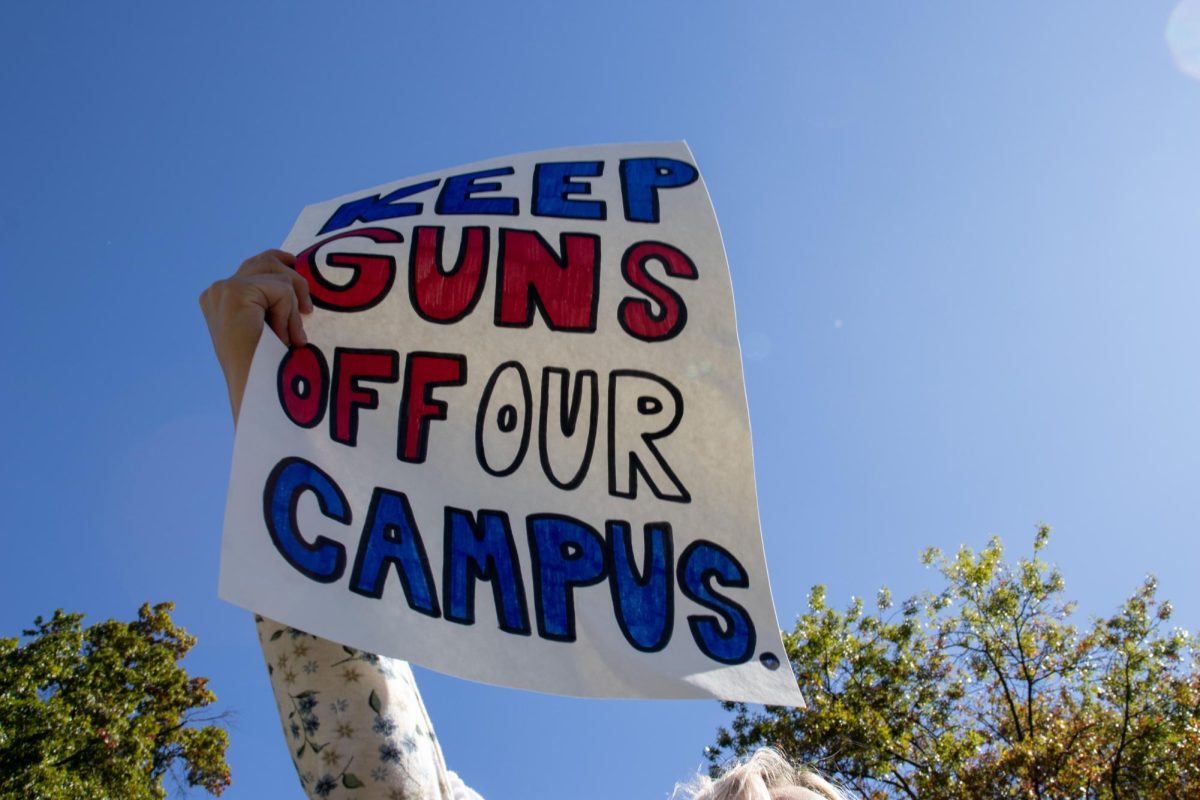
“And no one would be able to stop you if there’s no weapons, if there’s no repercussions, if there’s no police that have power,” Weir said. “You can’t tase a shotgun.”
AU rests in a low-crime area of Washington, according to Open Data D.C.’s crime data. Police precincts in Ward 3, encompassing AU and its surrounding neighborhoods, reported 20 violent crimes involving a gun between Jan. 1 and Nov. 21, the lowest of any ward, according to the data.
On and near campus, crime reported by AU decreased by 47.6% between 2022 and 2023, according to AU’s latest annual security report. That report is limited to crimes that the Clery Act requires universities to publicly report, including aggravated and sexual assault, robbery and weapons law violations.
Because of low crime near AU, some students, like petition author Katzenell, have questioned the need for increasing AUPD’s lethal and non-lethal weapons.
“Students generally feel safe walking around at night, especially white students, specifically, who have that privilege,” Katzenell said. “Why are we arming AUPD?”
Burleigh-Jones said at the Sept. 19 session considerations to arm AUPD are unrelated to incidents on AU’s campus. She said a university Board of Trustees member raised the question in response to nationwide incidents on campuses.
At least 94 people were killed by guns on college campuses between 2013 and 2022, and 115 more were injured, according to a Campus Safety magazine article. At the Sept. 19 education session, Morse gave a 2022 shooting at the University of Virginia and a 2023 shooting at Michigan State University as examples of armed officers not preventing shootings.
Jones-Brown said people fear mass shootings because we live in a difficult time for regulating firearms. But armed police officers’ bullets do not choose who they harm, she said.
“The problem with using handguns in self-defense is that bullets are non-discretionary,” Jones-Brown said. “They will harm people who should be harmed and people who are not threats.”
Jones-Brown also said weapons increase the likelihood police officers and civilians will escalate situations. Knowing that an officer is armed might heighten a person’s fear, leading them to act in ways they otherwise may not. She said this is especially true of men.
“Most of the masculinities research suggests that, you know, male members of the public may respond aggressively if they feel that they are in danger,” Jones-Brown said. “And there’s no greater danger than the possibility of being shot.”
“I don’t see AU investing in that.”
At the Oct. 9 forum for students against arming AUPD, Burleigh-Jones said administrators would consider budget cuts to pay for arming officers later in the feasibility study, which is set to conclude by December. Staff members raised the cost question at a forum the previous day, she said.
Students have raised budget concerns outside of that Oct. 9 forum, too, questioning what trade-offs an armed AUPD might bring.
Hutchinson said students should hesitate supporting increasing AUPD’s arsenal because they don’t know what budget cuts administrators might make.
“I think the students should know that there is a risk of us losing either an organization or a program that we have on campus,” Hutchinson said.
AU officials would have to purchase firearms from a dealer listed on MPD’s website and register each weapon with MPD, Lynch said. Morse said at the Oct. 28 briefing that AU is looking into types of firearms and dealers.
While the cost of firearms vary, most police departments arm their officers with Glock handguns, according to a 2008-2012 survey of 53 police departments conducted by the Police Executive Research Forum. These typically cost between about $350 and $600 per weapon, according to a Glock retail partner’s website. But police officers, including any sworn campus officer, can receive discounts of $75-100 on their weapons, according to Glock’s website.
To carry guns, armed campus police must undergo at least 56 hours of firearms training, or about 2.5 weeks, according to D.C. code. Some states like New Jersey and North Carolina require 11.5 and 16 weeks of firearms training respectively, according to the D.C. Justice Lab.
AUPD officers currently undergo 12 weeks of general training, including de-escalation techniques and how to carry impact and less-than-lethal weapons like pepper spray and an expandable baton, Morse said at the Sept. 19 education session.

Training questions come as AU aims to close a projected $68 million budget shortfall for fiscal year 2025, which Burleigh-Jones announced at a Sept. 25 budget community forum, more than double that of 2024.
AUPD and emergency management operated with $5.8 million in both fiscal years 2023 and 2024, according to last year’s budget report. Elizabeth Deal, AU’s deputy chief communications officer, did not provide information to AWOL regarding AUPD’s current training budget.
In order to carry firearms, AUPD officers would have to undergo the minimum training through a Washington-licensed firearm instructor, according to Lynch.
Using MPD’s list of firearms training instructors, AWOL found firearms trainings in Washington that ranged from $400 to $800 per officer, some of which were intended for special police officers, which includes university officers. But some of these trainings do not meet the minimum 56 hours.
Jones-Brown said effective training for armed police officers should include non-escalation tactics focused on not causing people anxiety or fear.
“When the officer has a gun out, hand on gun, during those kinds of questioning situations or detainment, people, I think rightfully so, become anxious and fearful, and then their anxiousness and fearfulness leads to officers being aggressive,” Jones-Brown said. “And that aggression, we’ve seen in multiple situations, turned deadly.”
Morgan said there is no realistic form of training that would make him comfortable with arming police.
He said he wants students, staff and faculty to be trained about what to expect from their campus police and when it’s appropriate to call armed campus police. AU administrators have not mentioned community-wide training in any of the sessions or forums. Morgan said it may be implausible at AU.
“We’re talking about what, 10 years worth of training of students, staff, faculty and campus security?” he said. “I don’t see AU investing in that.”
“Does it serve our purpose? Is it what we need?”
Expanding AUPD’s non-lethal weapons arsenal is still in the cards, according to the security review website.
During the Sept. 19 education session, Morse said a number of non-lethal weapons are “on the market,” listing tasers, launchers, wraps and nets as potential non-lethal options.
“We want to look at what we have,” Morse said. “Does it serve our purpose? Is it what we need? Is there something out there that’s better, more efficient and maybe even a step more aesthetically pleasing, if you will, from an impact weapon?”
But Greenstein, who was previously the president of the undergraduate Disabled Student Union, said those options could be lethal for some. They said people with heart conditions, autoimmune diseases and tissue disorders are especially vulnerable to non-lethal options. Greenstein, who has POTS, said a taser could be deadly.
“For the average individual, if you get tasered, you might not have a heart attack and die from it,” they said. “But if I get tasered, I might drop dead, and that’s terrifying.”
Katzenell said they might have been open to the possibility of AUPD expanding its number of non-lethal weapons, if not for the options Morse listed.
“But as they were listing types of non-lethal weapons, absolutely not,” Katzenell said. “They already have pepper spray and batons, so they have self-defense already.”




